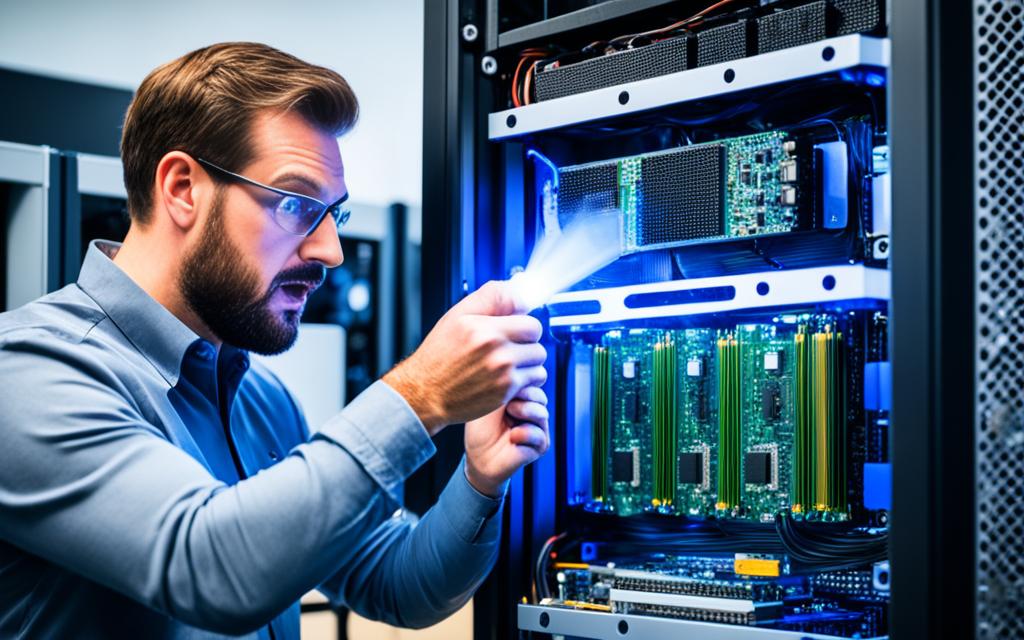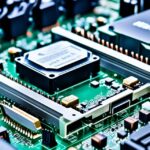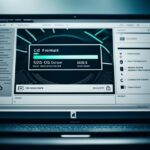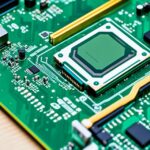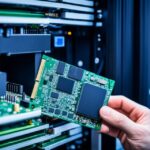Table of Contents
Feeling anxious or frustrated when your new Solid State Drive (SSD) doesn’t show up is common. This article is a detailed guide to help answer the frequent question: “Why is my new SSD not showing up?” There are many reasons why this issue might occur.
Understanding the main causes is crucial. Problems like installation mistakes, BIOS settings, drive initialization, and formatting issues can prevent the SSD from being detected. By carefully following the steps in this guide, you can quickly solve the problem and access your hardware again. For more detailed advice, check out the guide on fixing SSD not showing up issues.
Key Takeaways
- Common reasons for an SSD not appearing include incorrect installation and BIOS configuration.
- Correctly initialising and formatting the SSD are vital steps for Windows to detect it.
- Updating drivers can be crucial in solving SSD detection issues.
- Changing the drive letter can resolve detection conflicts.
- If problems continue, professional data recovery services may be needed.
Understanding SSD Detection Issues
Many users get upset by SSD detection issues, mainly due to SSD installation problems. If a newly installed SSD doesn’t appear, it may cause an “SSD not recognized” error in Windows. This affects about 30% of users because of outdated or damaged drivers1. Also, 5-10% might find detection hard because the SSD needs to be set up first2. It’s important to know that the problem isn’t always the SSD. The devices and settings it connects with are also key to finding it.
The links between hardware pieces like cables and ports are vital. Checking these connections as part of SSD troubleshooting helps fix the problem in about half the cases1. Also, if the BIOS doesn’t see the SSD, 3-7% of users feel the impact2. Memory problems or conflicts affect 5-9% and 6-11% of users, making it hard for the SSD to be recognized21.
Understanding the bigger picture of SSD detection is crucial before looking for solutions. Trying the SSD on a different PC is a good first step. This helps figure out if the problem is with the hardware or software. It shows that 15-20% of users find a specific issue with their setup2.
Common Reasons for SSD Not Appearing
Two main issues usually cause an SSD to not be detected. Knowing these can make fixing the problem easier.
Improper Installation of the SSD
Often, SSDs are not recognized because they’re not installed correctly. It’s important to connect the SATA cable tightly to both the SSD and motherboard. With NVMe SSDs, make sure they fit right in the slot and work with your motherboard. Simply reseating the SSD can help ensure everything is connected properly.
BIOS Settings Configuration
BIOS settings are crucial for SSD recognition. Wrong BIOS settings might list the SSD but Windows won’t see it. When you start your computer, getting into BIOS/UEFI to check the SSD settings is key. Ensure the SATA mode is on AHCI for the best SSD performance, unless you face compatibility issues. If ignored, the SSD might not be detected even when it’s installed right.
SSD issues can stem from various reasons, including poor connections or logical errors. Research345 shows that these factors can affect SSD reliability. By fixing installation and BIOS settings, you can likely solve detection problems and enjoy a smoothly running SSD3.
Why is my new SSD not showing up?
Several SSD not showing up reasons may keep your new SSD hidden. One big problem is that new SSDs often need to be set up before Windows can see them. If you don’t do this vital step, the SSD might show as empty space. This means SSD troubleshooting is key for those facing this issue4. Outdated or broken drivers can also stop your system from finding the SSD3. Issues with connections and hardware failures can make the SSD invisible too5.
Things like not having enough power can also mess with Windows detection issues. Some SSDs won’t work well or at all if they don’t get enough power. Overheating can also make your SSD hard to access. In some situations, if the file system breaks, the SSD won’t be recognized. This can be very annoying4. Also, certain SSD models may not fit well with your system’s setup, making it hard to find the SSD3.
To figure out what’s wrong with your new SSD, it’s crucial to understand these issues. Paying close attention to any odd things and following troubleshooting tips can really help. This way, you can make Windows see your SSD and set it up properly in your computer.
Steps to Physically Check Your SSD Installation
To fix issues with SSD being undetected, it’s key to check the installation first. Begin by thoroughly checking all connections and cables. Make sure everything is securely attached and not damaged. Next, power down your computer and take a closer look at the SSD itself. Ensure there’s no dust or damage on its connectors. A loose or damaged cable can cause problems with the SSD being recognized by the BIOS, as often seen in troubleshooting guides6.
Next, carefully reconnect the SATA or NVMe cables, making sure the power connector for SATA SSDs is firmly in place. Try using different SATA slots on your motherboard or different cables to rule out faulty parts. It’s also good to check for compatibility with your motherboard. Sometimes, updating your firmware can help fix installation issues or ensure settings are correct.
After getting everything connected, turn on your computer to check the BIOS for SSD status. This step helps spot any physical installation problems and can lead to better performance in the future. Following these troubleshooting steps can greatly increase the chances of your SSD being recognized, leading to a smoother computing experience7.
Checking and Updating BIOS Settings
Making sure your SSD works well in the BIOS is key for top performance. This usually means looking at and changing BIOS settings so the system detects the SSD correctly. By following certain steps carefully, you can improve your SSD’s chances of being recognised.
Accessing BIOS or UEFI
To get into the BIOS or UEFI, restart your computer and keep pressing a specific key. This key changes with the type of motherboard and might be F2, Del, or Esc. Once you’re in, you can check out the settings that are about SSD recognition.
Ensuring SATA Configuration is Correct
In the BIOS, you should find the storage options to make sure the SATA controller mode is right. It’s usually set to AHCI for the best SSD performance; however, you might pick IDE for certain needs. Sometimes, you also have to turn on certain SATA ports, especially with old motherboards. If these settings aren’t right, your SSD might not show up, even if it’s installed correctly8.
Saving your changes before you leave is crucial. This makes sure the new settings are used. Keeping the BIOS updated is good too, especially if your SSD doesn’t work because the BIOS is old9.
By carefully checking and updating your BIOS settings, you can make it more likely for your SSD to be recognised by Windows. This important step helps fix SSD detection problems, making your computer work better.
Initialising and Formatting the SSD
To set up the new SSD, you must initialise and format it in Windows. This lets the system see and use the drive well. Doing things correctly helps the SSD work at its best.
How to Initialise the SSD in Windows
To start the SSD in Windows, hit the Windows Key + X and pick ‘Disk Management’. Find the SSD you’ve just connected, right-click it, and select ‘Initialise Disk’. You’ll then choose between MBR or GPT for the partition style. GPT is often better for newer computers because it has more benefits.
Formatting Options: MBR vs GPT
Choosing how to format the SSD means knowing the difference between MBR and GPT. MBR is for disks up to 2TB and works with old systems. GPT, though, can handle bigger storages and offers extra features, perfect for modern setups. Once you decide, right-click the SSD’s unallocated space and pick ‘New Simple Volume’ to format. Formatting removes all data, so back up what you need first. Make sure the SSD shows up right in Device Manager and Disk Management. If you run into I/O errors during setup, it’s a common problem. Hooking the SSD directly to the motherboard with SATA works great every time for setting up GPT and formatting without issues10.
Knowing how to initialise and format your SSD is crucial. It lets you make smart choices that boost the drive’s performance and make it work well with your system10.
Changing the Drive Letter for Detection
Sometimes a drive letter conflict might be why your SSD is not showing up. You can fix this by changing the SSD’s drive letter through Windows Disk Management. This simple step often solves many detection issues.
To change the SSD drive letter, do the following:
- Open Disk Management by pressing Windows Key + X.
- Find the SSD that needs a new letter. Right-click on it and select ‘Change Drive Letter and Paths’.
- If there’s a current drive letter, click ‘Change’. If not, click ‘Add’. Then, pick a new letter and confirm it.
- Restart your computer so the changes can take effect.
Making this change can solve problems that stop your SSD from being seen. It ensures your system and storage devices work well together. This is key for your Windows system to run smoothly.
With this quick adjustment, you can sort out SSD detection problems. This leads to better system performance111213.
Conclusion
Fixing a new SSD that doesn’t show up can be a complex task. It involves detailed SSD troubleshooting. One must carefully check installation steps, BIOS settings, and understand how drives are managed. This increases the chance of making the SSD work145.
The process includes starting the SSD correctly and giving it a drive letter. Updating disk drivers and tweaking BIOS settings are also key steps. These actions are crucial for fixing SSD problems145.
SSDs offer better speed and use less power, making them attractive for upgrading computers. By following the right steps for troubleshooting, you can usually fix common issues like SSDs not starting or connection problems. This helps you get the most out of SSD technology5.
Working on these issues improves how your computer works and helps build a community. When people share how they solved their SSD problems, it helps others. This sharing makes everyone’s tech journey better and creates a learning space around technology145.
FAQ
Why is my new SSD not showing up in Windows?
Several reasons could cause your new SSD to not show up in Windows. These include not putting it in correctly, the BIOS needing adjustment, the SSD not being set up yet, or it needs formatting.
How do I know if my SSD is properly installed?
To make sure it’s installed right, check the connections between the SSD and the motherboard. The SATA or NVMe cables should be tight. Also, the drive must be placed properly in its slot.
What should I do if my BIOS does not recognise the SSD?
Enter the BIOS/UEFI settings when you start your computer. Make sure to set the SATA mode to AHCI for best performance, or IDE for compatibility. Also, enable the right SATA ports.
How can I initialise my SSD in Windows?
To get your SSD ready in Windows, press the Windows Key + X and select ‘Disk Management’. Look for your SSD, right-click it, and pick ‘Initialise Disk’. Choose between MBR or GPT based on your requirement.
What formatting options should I choose for my SSD?
For formatting, you can pick MBR (Master Boot Record) or GPT (GUID Partition Table). Use MBR for drives up to 2TB. GPT is better for larger drives in newer systems.
How do I change the drive letter of my SSD?
Press Windows Key + X and open Disk Management to find your SSD. Right-click it, select ‘Change Drive Letter and Paths’, and choose to add or change the letter as needed.
Could external factors cause my SSD to not be recognised?
Yes, things like power supply problems or a faulty motherboard could stop your SSD from being detected. Make sure your power connections are tight and the motherboard is working right.
What are the signs of improper SSD installation?
If your SSD is not installed right, it won’t show up in BIOS or Windows. You might see loose cables or the drive might not sit properly in its slot.
How can I check if my SSD is functioning correctly after installation?
Check your SSD’s status in Windows Disk Management after installing. You should see it listed there. Running diagnostic tools from the SSD’s maker can also help check if it’s working properly.
Source Links
- https://www.pitsdatarecovery.co.uk/blog/ssd-not-showing-up-disk-management/ – SSD Not Showing Up Disk Management
- https://www.makeuseof.com/6-ways-to-fix-the-ssd-not-recognized-error-in-windows-10/ – 6 Ways to Fix the “SSD Not Recognized” Error in Windows 10
- https://iboysoft.com/data-recovery/ssd-not-showing-up.html – SSD Not Showing Up in Windows 10/11, Fix With Quick Ways
- https://hdsentinel.com/blog/new-ssd-not-showing-up – How To Fix My New SSD Not Showing Up? – Solutions and Data Recovery
- https://www.diskgenius.com/how-to/ssd-not-showing-up.php – Fixed: SSD Not Showing Up in Windows 10/8/7 | 6 Solutions
- https://www.easeus.com/computer-instruction/ssd-not-detected-in-bios.html – SSD Not Detected in BIOS | Top 8 Ways to Fix🔥
- https://community.wd.com/t/did-not-detect-ssd/281589 – Did not detect ssd
- https://www.partitionwizard.com/partitionmanager/ssd-not-showing-up-in-bios.html – 4 Ways to Fix SSD Not Showing Up in BIOS – MiniTool Partition Wizard
- https://recoverit.wondershare.com/harddrive-errors/fix-bios-not-detecting-ssd-in-computer.html – Fix BIOS Not Detecting SSD in Computer | 11 Tips[2024]
- https://superuser.com/questions/1516454/ssd-does-not-initialize-and-does-not-appear-on-this-pc – SSD does not initialize and does not appear on “This PC”
- https://recoverit.wondershare.com/harddrive-tips/ssd-not-showing-or-detected.html – 7 Solutions to SSD Not Showing Up or Detected in Windows Error
- https://www.easeus.com/data-recovery-solution/nvme-ssd-not-detected.html – NVME Not Showing Up in BIOS and Disk Management [SOLVED 2024]
- https://www.easeus.com/storage-media-recovery/ssd-not-showing-up-windows-10.html – Fix SSD Not Showing Up in Windows 10/11 [2024 Tips]
- https://www.easeus.com/partition-manager-software/ssd-not-showing-up-in-disk-management.html – Solved: SSD Not Showing Up in Disk Management on Windows 10/11/8/7

